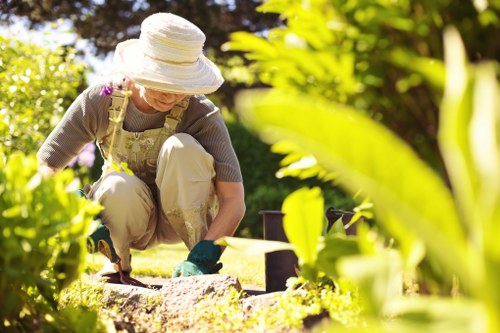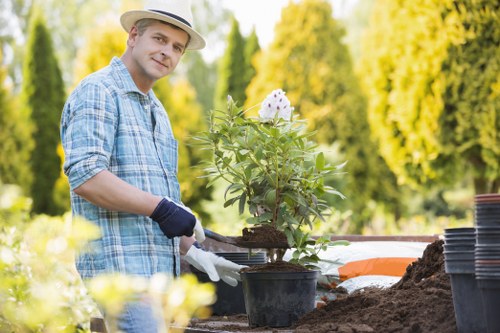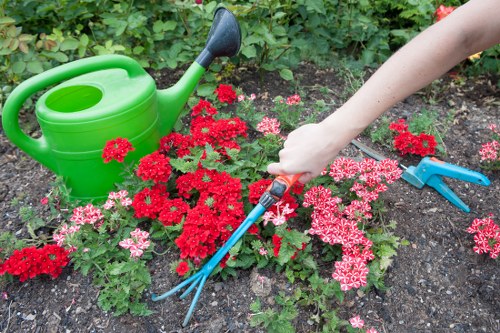Landscaping in Victoria

Landscaping in Victoria is an art and science that transforms outdoor spaces into aesthetically pleasing and functional environments. Whether you reside in Melbourne's bustling urban landscape or the serene countryside of Victoria, effective landscaping can significantly enhance your property's value and curb appeal.
Victoria's diverse climate and unique geography offer a plethora of opportunities for creating stunning landscapes. From lush gardens to minimalist outdoor spaces, the possibilities are endless. Understanding the local conditions and selecting appropriate plants and materials are crucial for successful landscaping.
Engaging with professional landscapers in Victoria ensures that your outdoor space is tailored to your specific needs and preferences. Experienced landscapers bring expertise in design, plant selection, and maintenance, ensuring a harmonious and sustainable landscape.

The Benefits of Landscaping
Investing in landscaping brings numerous benefits beyond mere aesthetics. A well-designed landscape can improve the overall health of your property, provide environmental benefits, and enhance your quality of life.
Environmental Benefits: Landscaping plays a vital role in environmental conservation. Plants help in reducing air pollution, providing shade, and conserving water. Incorporating native plants can support local wildlife and promote biodiversity.
Property Value: A beautifully landscaped property is more attractive to potential buyers and can significantly increase your property's market value. Features like well-maintained gardens, pathways, and outdoor lighting can make your home stand out.

Popular Landscaping Styles in Victoria
Native and Drought-Tolerant Plants
With Victoria's varying climate, using native and drought-tolerant plants is both practical and environmentally friendly. These plants require less water and are more resilient against local pests and diseases, making them ideal for sustainable landscaping.
Some popular native plants include the Bottlebrush, Grevillea, and Kangaroo Paw. Incorporating these plants can create a vibrant and low-maintenance garden that thrives in Victoria's climate.
Drought-tolerant plants not only reduce water consumption but also add unique textures and colors to your landscape. Succulents, lavender, and ornamental grasses are excellent choices for creating visually appealing and sustainable outdoor spaces.

Modern Minimalist Designs
Modern minimalist landscaping focuses on simplicity, clean lines, and uncluttered spaces. This style often employs a limited color palette, geometric shapes, and minimal plant varieties to create a serene and sophisticated atmosphere.
Key elements include the use of concrete, metal, and glass materials, as well as strategically placed lighting to highlight architectural features. Minimalist gardens are perfect for those who prefer a low-maintenance yet elegant outdoor space.
Incorporating elements like water features or sculptural plants can add interest without compromising the minimalist aesthetic. This style is particularly popular in urban settings where space is limited.

Traditional Gardens
Traditional gardens are characterized by structured layouts, symmetrical designs, and a rich variety of plants. This style often includes features like lawns, flower beds, hedges, and ornamental trees, creating a picturesque and timeless appeal.
Pathways and benches are common elements in traditional gardens, providing both functionality and aesthetic value. Stone or brick pathways guide visitors through the garden, while benches offer places to relax and enjoy the surroundings.
The use of classic materials such as wrought iron, wood, and stone complements the traditional design, ensuring that the garden remains elegant and enduring. Seasonal flowers and perennial plants add continuous color and interest throughout the year.

Services Offered in Victoria Landscaping
Design and Consultation
The first step in any landscaping project is the design and consultation phase. Professional landscapers work closely with clients to understand their vision, preferences, and budget. This collaborative process ensures that the final design aligns with the client's expectations and functional needs.
During consultation, sites are assessed for their environmental conditions, existing structures, and potential challenges. Detailed plans are then created, incorporating elements like plant selection, layout, and material choices to create a cohesive design.
Advanced design tools and software are often used to provide clients with a realistic preview of their future landscape, allowing for adjustments and refinements before implementation begins.

Installation
Once the design is finalized, the installation phase begins. This involves the physical implementation of the landscaping plan, including planting, hardscaping, and installing features like irrigation systems and lighting.
Professional installation ensures that all elements are executed correctly and efficiently. Proper planting techniques, soil preparation, and material installation are critical for the longevity and health of the landscape.
Skilled landscapers manage the logistics of the installation process, coordinating different trades and suppliers to ensure that the project stays on schedule and within budget.

Maintenance
Ongoing maintenance is essential to preserve the beauty and functionality of your landscape. Professional landscaping services in Victoria offer regular maintenance plans that include tasks like pruning, mowing, fertilizing, and pest control.
Maintenance services ensure that plants remain healthy, pathways stay clear, and hardscape features are kept in good condition. Regular upkeep can prevent minor issues from becoming major problems, saving time and money in the long run.
Customized maintenance plans are tailored to the specific needs of the landscape, considering factors like plant types, seasonal changes, and client preferences.

Choosing the Right Landscaping Company in Victoria
Selecting a reputable and experienced landscaping company is crucial for achieving the desired results. Here are some key factors to consider when choosing a landscaper in Victoria:
- Experience and Expertise: Look for companies with a proven track record and expertise in the type of landscaping you desire.
- Portfolio: Review their previous projects to gauge their design style and quality of work.
- References and Reviews: Check testimonials and reviews from past clients to assess their reliability and customer satisfaction.
- Licensing and Insurance: Ensure the company is properly licensed and insured to protect against potential liabilities.
- Communication: Choose a company that listens to your ideas and communicates clearly throughout the project.
Taking the time to research and evaluate different landscaping companies will help you find a partner that can bring your vision to life efficiently and effectively.

Seasonal Considerations for Landscaping in Victoria
Victoria experiences a range of seasons, each presenting unique challenges and opportunities for landscaping. Understanding these seasonal variations is essential for designing a resilient and thriving landscape.
Spring
Spring is an ideal time for planting new vegetation and preparing your garden for the growing season. Focus on sowing seeds, planting bulbs, and mulching to retain soil moisture and suppress weeds.
Summer
During the summer months, ensure proper irrigation to keep plants hydrated. Implementing water-efficient systems like drip irrigation can help manage water usage effectively.
Autumn
Autumn is perfect for pruning trees and shrubs, as well as planting perennials that will establish themselves before winter. Clearing fallen leaves and debris helps maintain a neat appearance.
Winter
Winter maintenance involves protecting sensitive plants from frost, pruning deciduous trees, and planning for the next planting season. Utilizing frost cloths and other protective measures can safeguard your landscape during colder months.

Sustainable Landscaping Practices
Sustainability is increasingly important in modern landscaping. Implementing eco-friendly practices not only benefits the environment but also creates a resilient landscape that can adapt to changing conditions.
Water Conservation
Incorporate water-efficient irrigation systems, rainwater harvesting, and drought-resistant plants to minimize water usage. Proper planning and installation can significantly reduce your landscape's water footprint.
Soil Health
Maintaining healthy soil through composting, mulching, and avoiding excessive chemical use promotes plant growth and resilience. Healthy soil is the foundation of a thriving landscape.
Native Plant Selection
Choosing native plants supports local ecosystems and reduces the need for additional resources. Native species are adapted to the local climate and soil conditions, requiring less maintenance and care.

Cost Factors in Landscaping
Understanding the various cost factors involved in landscaping can help you plan your budget effectively. Several elements influence the overall cost of a landscaping project:
- Design Complexity: Intricate and detailed designs require more time and resources, increasing costs.
- Plant Selection:
- Type and quantity of plants affect the budget. Rare or large plants are typically more expensive.
- Materials and Hardscaping:
- The choice of materials for paths, patios, and structures impacts costs. High-quality materials may have a higher upfront cost but offer durability and longevity.
- Labor Costs:
- Professional labor is a significant factor. Experienced landscapers may charge higher rates, but they ensure quality and efficiency.
- Maintenance Requirements:
- Ongoing maintenance services add to the long-term cost but are essential for preserving the landscape.
Carefully planning and prioritizing your landscaping elements can help manage costs without compromising on quality or aesthetics.

Common Landscaping Challenges and Solutions
Landscaping projects often encounter various challenges, especially in regions like Victoria with diverse climatic conditions. Addressing these challenges effectively ensures a successful and sustainable landscape.
Soil Quality
Poor soil quality can hinder plant growth and overall landscape health. Conducting soil tests and amending the soil with necessary nutrients and organic matter can improve its structure and fertility.
Water Management
Managing water efficiently is crucial to prevent issues like flooding or drought stress. Implementing proper drainage systems and choosing water-efficient plants can help maintain optimal moisture levels.
Pest Control
Pests can damage plants and disrupt the landscape's balance. Utilizing integrated pest management practices, such as introducing natural predators and minimizing chemical use, can control pest populations sustainably.

Trends in Victoria Landscaping
Landscaping trends evolve with changing lifestyles, environmental considerations, and design innovations. Staying updated with the latest trends can inspire and enhance your own landscape.
Outdoor Living Spaces
Creating functional outdoor living areas, including patios, kitchens, and lounge spaces, has become increasingly popular. These spaces extend the usable area of your home and provide a perfect venue for relaxation and entertainment.
Edible Gardens
Incorporating edible plants like vegetables, herbs, and fruit trees into the landscape is a growing trend. Edible gardens promote sustainability and offer the added benefit of fresh produce.
Smart Landscaping
The integration of technology in landscaping, such as automated irrigation systems, smart lighting, and landscape management apps, enhances efficiency and convenience.
Eco-Friendly Practices
Emphasizing sustainability, eco-friendly landscaping practices like using recycled materials, reducing chemical use, and promoting biodiversity are becoming mainstream.

Conclusion
Landscaping in Victoria offers endless opportunities to create beautiful, functional, and sustainable outdoor spaces. Whether you prefer traditional gardens, modern minimalist designs, or eco-friendly landscapes, understanding the local climate and working with professional landscapers can help you achieve your vision.
Investing in quality landscaping not only enhances the aesthetic appeal of your property but also provides environmental and economic benefits. Embrace the art of landscaping to transform your outdoor area into a sanctuary that reflects your style and meets your needs.
Ready to transform your outdoor space? Contact us today to discuss your landscaping needs and book your service now.

